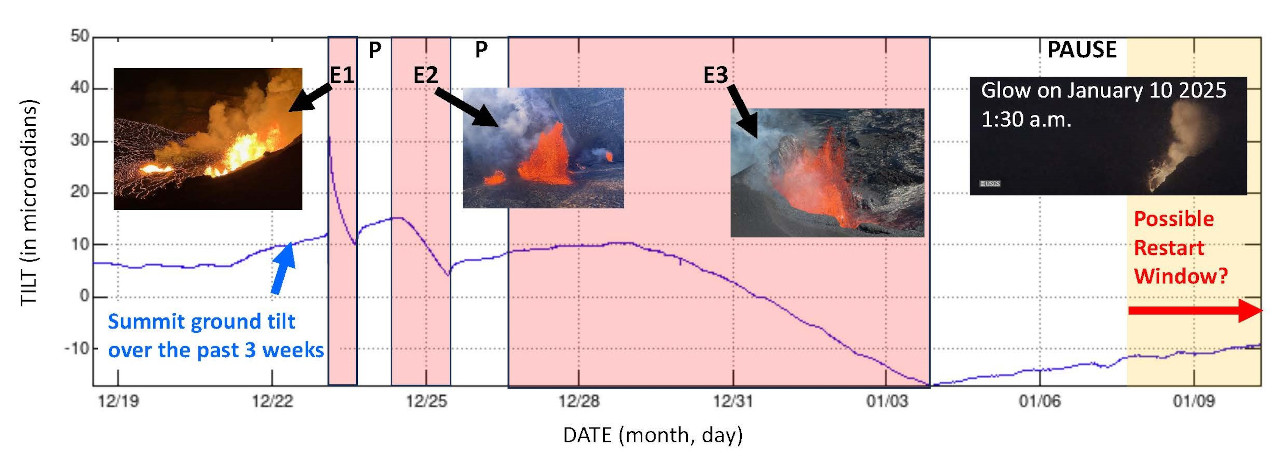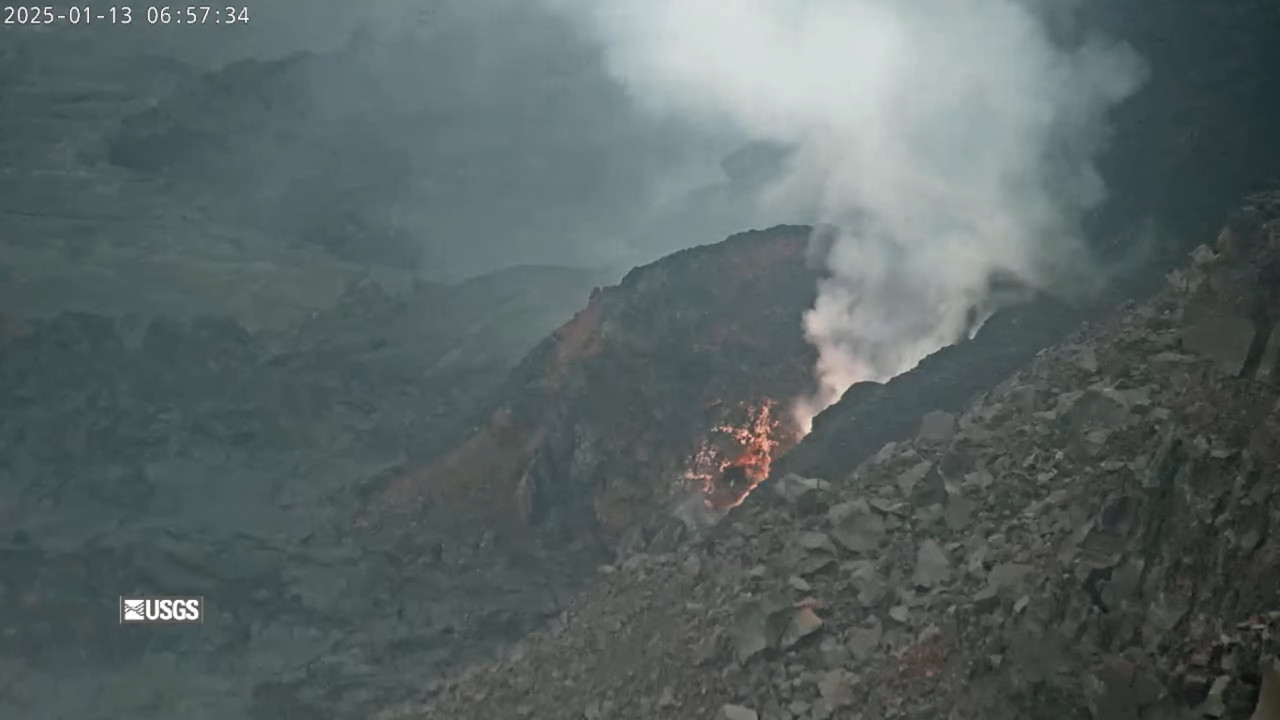(BIVN) – The summit eruption at Kīlauea volcano remains paused, although some lava spattering has recently been visible at the inactive vents.
The USGS Alert Level for Kīlauea remains at WATCH. No unusual activity has been noted along Kīlauea’s East Rift Zone or Southwest Rift Zone.
In a Monday morning update, the USGS Hawaiian Volcano Observatory reported “last night saw less spattering at the northern eruptive vent than the night before, but persistent glow indicates that lava remains close to the surface on the southwest side of Kaluapele, the volcano’s summit caldera.”
From the USGS HVO update on Monday, January 13:
Summit Instrumental Observations: Seismicity in the summit region remains low, with only 3 small earthquakes (all below M2.0) detected in the past 24 hours. Seismic tremor remains near background levels, indicating very little activity at the eruptive vents. Summit tiltmeters began tracking inflation on January 3 around the same time that the single remaining lava fountain shut down. This inflation continued at a relatively low rate through yesterday evening, when the tiltmeters began tracking slight deflation; it remains to be seen if this is just a temporary disruption in the inflationary trend, or a more lasting reversal. The most recently measured sulfur dioxide (SO2) emission rate was approximately 500 tonnes per day on Friday, January 10. Though significantly lower than rates measured during more energetic eruptive activity, this value still represents above-background SO2 emissions, and the resulting hazard will be affected by wind conditions (see Hazards section below).
Summit Eruption Observations: Yesterday evening, visitors to Hawai‘i Volcanoes National Park reported seeing low-level spattering at the northern eruptive vent on the southwest side of Kaluapele, within Halema‘uma‘u crater. However, this spattering was not clearly discernible in live stream camera views, so lava was likely not thrown any higher than 5 yards (meters), remaining within the vent. It is unclear if spattering continues this morning, but persistent glow from both the northern and southern eruptive vents indicates that lava remains close to the surface, likely just a few yards (meters) below the crater floor. At this time, no new lava flows have yet exited the vents. The area where HVO’s automatic laser rangefinder is pointing on the crater floor—a few hundred yards (meters) northeast of the vents—remains stable, so there is no ongoing emplacement of lava below surface crust on the crater floor.

USGS: “Ground tilt and eruptive episodes associated with Kīlauea summit eruption December 23, 2024, to January 10, 2025. Eruptive episodes are highlighted in red. Fountain Episode 1 (E1) began at 2:20 a.m. HST on December 23, 2024, and continued until 4 p.m. that day (14 hours duration). Fountain Episode 2 (E2) began at 8 a.m. HST on December 24, 2024, and continued until 11 a.m. HST on December 25 (15 hours duration). Fountain Episode 3 (E3) began at 8 a.m. HST on December 26, 2024, and continued until 8:30 p.m. HST on January 3, 2025 (8 and a half days duration). Assuming the eruptive vent(s) remains open, indicated by continued glow and degassing, and inflation rate remains constant, a new episode could potentially begin sometime between January 8 and January 13, when ground tilt at Uēkahuna is expected to reach 12 microradians, about double prior post-fountain tilt increases.”
Rift Zone Observations: Seismicity remains low in both the East Rift Zone and Southwest Rift Zone, with counts of shallow earthquakes at background levels. The ESC tiltmeter in the upper East Rift Zone was tracking deflation in association with the summit eruption, but its tilt trend has flattened during the ongoing pause. Deformation rates remain low in the middle and lower East Rift Zone and in the Southwest Rift Zone, as recorded by GPS instruments and tiltmeters.
Analysis: The current eruption at the summit of Kīlauea is the sixth eruption within Kaluapele since 2020. These eruptions in the summit region have lasted from one week to more than a year in duration. Like most of the other eruptions, this event began with vigorous lava effusion and volcanic gas emissions, but it has paused three times. Episodes 2 and 3 of this eruption were preceded by re-inflation of the summit; the rapid change from deflationary tilt to inflationary tilt at the time of the pause on January 3 suggests that another eruptive episode may occur in the coming days to weeks if the summit’s magma chambers repressurize sufficiently. The return of low-level spattering in recent days could be the result of rising lava within the eruptive vents, indicating that the resumption of more energetic activity may be getting closer.
Summit eruptions observed over the past 60 years have exhibited vigorous activity in the opening days which can episodically wax and wane, or drop over time to more sustainable low effusion rates, or slowly diminish and end.
HVO continues to closely monitor Kīlauea and is in contact with Hawai‘i Volcanoes National Park and the Hawai‘i County Civil Defense Agency about eruptive hazards.


by Big Island Video News7:28 am
on at
STORY SUMMARY
HAWAIʻI VOLCANOES NATIONAL PARK - Still no eruption at the summit of Kīlauea, although some lava spattering has been visible at the inactive vents.